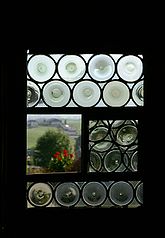
Crown glass (window)
Encyclopedia

Glassblowing
Glassblowing is a glassforming technique that involves inflating molten glass into a bubble, or parison, with the aid of a blowpipe, or blow tube...
into a "crown" or hollow globe. This was then transferred from the blowpipe
Blowpipe (tool)
The term blowpipe refers to one of several tools used to direct streams of gases into any of several working media.- Blowpipes for torches :...
to a pontil and then flattened by reheating and spinning out the bowl-shaped piece of glass (bullion) into a flat disk by centrifugal force
Centrifugal force
Centrifugal force can generally be any force directed outward relative to some origin. More particularly, in classical mechanics, the centrifugal force is an outward force which arises when describing the motion of objects in a rotating reference frame...
, up to 5 or 6 feet (1.5 to 1.8 metres) in diameter. The glass was then cut to the size required.
The thinnest glass was in a band at the edge of the disk, with the glass becoming thicker and more opaque toward the center.
Due to the distribution of the best glass, in order to fill large window spaces many small diamond shapes would be cut from the edge of the disk and these would be mounted into a lead lattice work and fitted in the window. Known as a bullseye
Crown glass (window)
Crown glass was an early type of window glass. In this process, glass was blown into a "crown" or hollow globe. This was then transferred from the blowpipe to a pontil and then flattened by reheating and spinning out the bowl-shaped piece of glass into a flat disk by centrifugal force, up to 5 or...
, the thicker center area around the pontil mark
Pontil mark
A Pontil mark or punt mark is the scar where the pontil, punty or punt was broken from a work of blown glass. The presence of such a scar indicates that a glass bottle or bowl was blown freehand, while the absence of a punt mark suggests either that the mark has been obliterated or that the work...
was used for less expensive windows.
Crown glass was one of the two most common processes for making window glass until the 19th century. The other was blown plate
Blown plate
Blown plate is one of many types of hand-blown glass. It is made from broad sheet glass by laboriously hand grinding and polishing both surfaces. Blown plate is of a sufficient quality and size for mirrors and coach glasses....
. The process was first perfected by French glassmakers in the 1320s, notably around Rouen
Rouen
Rouen , in northern France on the River Seine, is the capital of the Haute-Normandie region and the historic capital city of Normandy. Once one of the largest and most prosperous cities of medieval Europe , it was the seat of the Exchequer of Normandy in the Middle Ages...
, and was a trade secret. As a result, crown glass was not made in London until 1678.
Crown glass is one of many types of hand-blown glass. Other methods include: broad sheet
Broad sheet
Broad sheet is a type of hand-blown glass. It is made by blowing molten glass into an elongated balloon shape with a blowpipe. Then, while the glass is still hot, the ends are cut off and the resulting cylinder is split with shears and flattened on an iron plate. . The quality of broad sheet...
, blown plate
Blown plate
Blown plate is one of many types of hand-blown glass. It is made from broad sheet glass by laboriously hand grinding and polishing both surfaces. Blown plate is of a sufficient quality and size for mirrors and coach glasses....
, polished plate
Polished plate
Polished plate is a type of hand-blown glass. It is produced by casting glass onto a table and then subsequently grinding and polishing the glass. This was originally done by hand, and then later by machine...
and cylinder blown sheet
Cylinder blown sheet
Cylinder blown sheet is a type of hand-blown window glass. It is created with a similar process to broad sheet, but larger cylinders are produced by swinging the cylinder in a trench. The glass is then allowed to cool before the cylinder is cut. The glass is then re-heated and flattened...
. These methods of manufacture lasted at least until the end of the 19th century. The early 20th century marks the move away from hand-blown to machine manufactured glass such as rolled plate, machine drawn cylinder sheet
Machine drawn cylinder sheet
Machine drawn cylinder sheet was the first mechanical method for "drawing" window glass. Cylinders of glass 40 feet high are drawn vertically from a circular tank. The glass is then annealed and cut into 7 to 10 foot cylinders. These are cut lengthways, reheated, and flattened.This process...
, flat drawn sheet, single and twin ground polished plate and float glass
Float glass
Float glass is a sheet of glass made by floating molten glass on a bed of molten metal, typically tin, although lead and various low melting point alloys were used in the past. This method gives the sheet uniform thickness and very flat surfaces. Modern windows are made from float glass...
.

